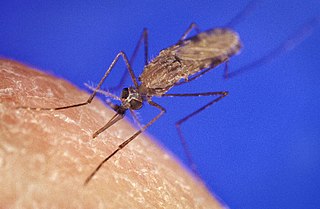Related Research Articles

Insecticides are substances used to kill insects. They include ovicides and larvicides used against insect eggs and larvae, respectively. Insecticides are used in agriculture, medicine, industry and by consumers. Insecticides are claimed to be a major factor behind the increase in the 20th-century's agricultural productivity. Nearly all insecticides have the potential to significantly alter ecosystems; many are toxic to humans and/or animals; some become concentrated as they spread along the food chain.

Cytochromes P450 (CYPs) are a superfamily of enzymes containing heme as a cofactor that function as monooxygenases. In mammals, these proteins oxidize steroids, fatty acids, and xenobiotics, and are important for the clearance of various compounds, as well as for hormone synthesis and breakdown. In 1963, Estabrook, Cooper, and Rosenthal described the role of CYP as a catalyst in steroid hormone synthesis and drug metabolism. In plants, these proteins are important for the biosynthesis of defensive compounds, fatty acids, and hormones.

The Anopheles gambiae complex consists of at least seven morphologically indistinguishable species of mosquitoes in the genus Anopheles. The complex was recognised in the 1960s and includes the most important vectors of malaria in sub-Saharan Africa, particularly of the most dangerous malaria parasite, Plasmodium falciparum. It is one of the most efficient malaria vectors known. The An. gambiae mosquito additionally transmits Wuchereria bancrofti which causes lymphatic filariasis, a symptom of which is elephantiasis.

In enzymology, a sterol 14-demethylase (EC 1.14.13.70) is an enzyme of the Cytochrome P450 (CYP) superfamily. It is any member of the CYP51 family. It catalyzes a chemical reaction such as:

Cytochrome P450 3A5 is a protein that in humans is encoded by the CYP3A5 gene.

Cytochrome P450 3A43 is a protein that in humans is encoded by the CYP3A43 gene.

CYP2R1 is cytochrome P450 2R1, an enzyme which is the principal vitamin D 25-hydroxylase. In humans it is encoded by the CYP2R1 gene located on chromosome 11p15.2. It is expressed in the endoplasmic reticulum in liver, where it performs the first step in the activation of vitamin D by catalyzing the formation of 25-hydroxyvitamin D.

CYP27C1 is a protein that in humans is encoded by the CYP27C1 gene.

The halloween genes are a set of genes identified in Drosophila melanogaster that influence embryonic development. All of the genes code for cytochrome P450 enzymes in the ecdysteroidogenic pathway (biosynthesis of ecdysone from cholesterol). Ecdysteroids such as 20-hydroxyecdysone and ecdysone influence many of the morphological, physiological, biochemical changes that occur during molting in insects.

A genetically modified (GM) insect is an insect that has been genetically modified, either through mutagenesis, or more precise processes of transgenesis, or cisgenesis. Motivations for using GM insects include biological research purposes and genetic pest management. Genetic pest management capitalizes on recent advances in biotechnology and the growing repertoire of sequenced genomes in order to control pest populations, including insects. Insect genomes can be found in genetic databases such as NCBI, and databases more specific to insects such as FlyBase, VectorBase, and BeetleBase. There is an ongoing initiative started in 2011 to sequence the genomes of 5,000 insects and other arthropods called the i5k. Some Lepidoptera have been genetically modified in nature by the wasp bracovirus.
Drosophila sechellia is a species of fruit fly, used in lab studies of speciation because it can mate with Drosophila simulans.
Insect olfactory receptors are expressed in the cell membranes of the olfactory sensory neurons of insects. Similarly to mammalian olfactory receptors, in insects each olfactory sensory neuron expresses one type of OR, allowing the specific detection of a volatile chemical. Differently to mammalian ORs, insect ORs form a heteromer with a fixed monomer, Orco, and a variable OR monomer, which confers the odour specificity.
ERG5 or Sterol 22-desaturase is a cytochrome P450 enzyme in the ergosterol biosynthesis pathway of fungi Saccharomyces cerevisiae, with the CYP Symbol CYP61A1. CYP61A1 is one of only three P450 enzyme found in baker's yeast, the other two are CYP51F1 and CYP56A1. The ortholog in Schizosaccharomyces pombe, was named CYP61A3 for historical reasons, and is only one of two P450 enzyme found with CYP51F1. ERG5 catalyzes the C22-C23 double bond formation on the sterol side chain of ergostatrienol to convert it into ergostatetraenol, then the C24 double bond of ergostatetrenol will be hydrogenation reduced into ergosterol by ERG4.
CYP318A1 is a Drosophila melanogaster gene belongs to the cytochrome P450 family, involved in the insecticide resistance.
Cytochrome P450, family 9, also known as CYP9, is a cytochrome P450 family found in Insect genome, CYP9 and insect CYP6 family belong to the same clan as mammalian CYP3 and CYP5 families. The first gene identified in this family is the CYP9A1 from the Heliothis virescens, which is involved in thiodicarb insecticide resistance. Subfamily CYP9A in Lepidopteran play important roles in insecticide resistance, can metabolize esfenvalerate efficiently.
Cytochrome P450, family 18, also known as CYP18, is an animal cytochrome P450 family found in insect genomes. It is involved in insecticide resistance. The first member gene identified was CYP18A1, from a Drosophila melanogaster fly, acting as a dimethylnitrosamine demethylase.
Cytochrome P450, family 6, also known as CYP6, is a cytochrome P450 family found in Insect genome. CYP6 and CYP9, another insect CYP family, belong to the same clan as mammalian CYP3 and CYP5 families.
Cytochrome P450, family 12, also known as CYP12, is a cytochrome P450 family found in insect genome belongs to Mitochondrial clan CYPs, which is located in the inner membrane of mitochondria(IMM). The first gene identified in this family is the CYP12A1 from the Musca domestica, which is involved in insecticide resistance. CYP12A1 protein localization in mitochondria by immunohistochemistry and absolute dependence on mitochondrial electron donors adrenodoxin reductase and adrenodoxin.
Cytochrome P450, family 305, also known as CYP305, is an animal cytochrome P450 family found in insect genome. The first gene identified in this family is the CYP305A1 from the Drosophila melanogaster.
CYP6M2 is a gene location in Anopheles gambiae chromosome 3R, involved in the insecticide resistant. The enzyme encoded by this gene is capable of directly metabolizing pyrethroids, belongs to the cytochrome P450 family CYP6
References
- ↑ McCart C, ffrench-Constant RH (June 2008). "Dissecting the insecticide-resistance- associated cytochrome P450 gene Cyp6g1". Pest Management Science. 64 (6): 639–645. doi: 10.1002/ps.1567 . PMID 18338338.
- ↑ Le Goff G, Hilliou F (March 2017). "Resistance evolution in Drosophila: the case of CYP6G1". Pest Management Science. 73 (3): 493–499. doi:10.1002/ps.4470. PMID 27787942.
- 1 2 Clark AG, Eisen MB, Smith DR, Bergman CM, Oliver B, Markow TA, et al. (Drosophila 12 Genomes Consortium) (November 2007). "Evolution of genes and genomes on the Drosophila phylogeny". Nature. Nature Portfolio. 450 (7167): 203–218. Bibcode:2007Natur.450..203C. doi: 10.1038/nature06341 . PMID 17994087. S2CID 2416812.